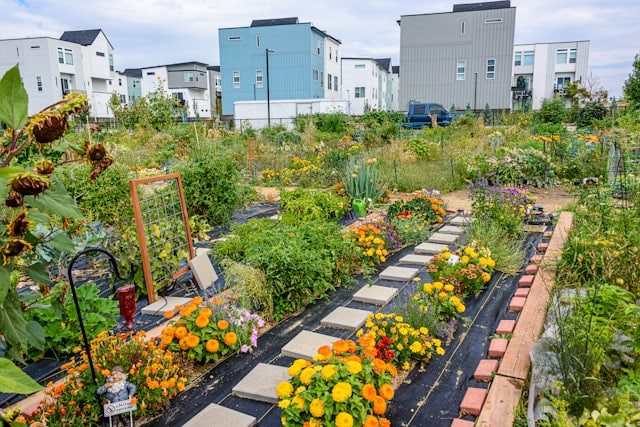How to Integrate Community Gardens into Urban Real Estate Developments?

As urban areas continuously grow and expand, the need to incorporate green spaces becomes an urgent priority. Amid the concrete jungle of high-rise buildings and bustling streets, community gardens serve as a breath of fresh air. Not only are these gardens aesthetically appealing, but they also contribute to the well-being of local residents, the vitality of the city, and the overall health of the urban environment. In this article, we will explore how to integrate community gardens into urban real estate developments.
The Power of Community Gardens
Before diving into the hows, let’s first understand the why behind community gardens. These green spaces, often located on vacant lots or unused land, are tended to by local residents. The food produced is often shared among the gardeners or donated to local food banks. But their benefits extend far beyond food production.
A découvrir également : What Customer Relationship Management Systems Are Most Effective for Real Estate Agencies?
Community gardens bring people together. They foster connections among neighbors, promote physical activity, and provide a space for relaxation and recreation. Gardening can reduce stress levels, improve mental health, and promote physical well-being. Additionally, community gardens serve as educational spaces where children and adults alike can learn about food cultivation and environmental stewardship.
Moreover, community gardens contribute to the city’s environmental health. They improve air and soil quality, encourage biodiversity, and provide a habitat for urban wildlife. They can also serve as a form of climate adaptation by reducing urban heat islands and managing stormwater.
Sujet a lire : What Are the Pros and Cons of Installing Underfloor Heating in UK Homes?
Integrating Community Gardens into Real Estate Development Plans
It’s clear that community gardens are an asset to urban spaces. So, how can they be incorporated into real estate development plans? The first step is for urban developers to recognize the value of these spaces and prioritize their inclusion in planning stages.
One approach is to incorporate community gardens into the design of new residential or commercial buildings. For instance, rooftop gardens are becoming an increasingly popular feature in urban developments. They provide residents with a shared space to grow food and connect with their neighbors, while also contributing to the building’s sustainability goals.
Another strategy is to utilize vacant lots or underused spaces for community gardens. Instead of leaving these areas empty or turning them into parking lots, developers can create vibrant, green spaces that benefit the local community and the environment.
Developers can also partner with local gardening organizations or nonprofits. These partnerships can provide the necessary resources and expertise to establish and manage the garden, while also ensuring that it remains a community-led initiative.
Enhancing Community Engagement Through Gardens
Once a community garden is incorporated into a real estate development, it’s essential to engage the local community in its operation and maintenance. The success of a community garden is largely dependent on the involvement of local residents.
Holding community meetings or workshops can help gather input on garden design, plant selection, and management practices. This process not only ensures the garden meets the community’s needs and preferences but also fosters a sense of ownership and responsibility among residents.
Beyond the initial planning stages, regular gardening workshops, harvest festivals, and other community events can keep residents engaged and invested in the garden. It’s also important to consider the diverse needs and abilities of residents. For example, raised garden beds can make gardening more accessible for seniors or individuals with physical disabilities.
The Role of Cities in Supporting Community Gardens
While real estate developers play a crucial role in creating community gardens, city governments are equally essential for their support and protection.
Cities can support community gardens by providing funding, resources, and technical assistance. They can also establish policies that protect community gardens from development pressures. For instance, cities can designate community gardens as protected green spaces or provide long-term leases that ensure their longevity.
Some cities have even created programs to transform vacant city-owned land into community gardens. This not only addresses issues of urban blight but also creates opportunities for local food production and community development.
Taking the Green Route in Urban Development
In the quest for urban development, we must not oversee the importance of green spaces. Community gardens are a testament to the benefits that green spaces bring to urban areas. They enhance the quality of life for city dwellers, promote environmental sustainability, and foster community connections.
By incorporating community gardens into real estate developments, we can create cities that are not only economically prosperous but also socially vibrant and environmentally healthy. So, let’s take the green route in urban development and sow the seeds of community gardens for a better urban future.
Remember, green growth is sustainable growth.
Fostering Ecosystem Development Through Community Gardens
Community gardens serve as a microcosm of larger ecosystems. Their role in promoting biodiversity and fostering the growth of native plants and wildlife should not be underestimated. Amid the urban landscape, community gardens become an important refuge for a variety of species, contributing significantly to the city’s ecological footprint.
In designing urban gardens, developers must respect and appreciate the potential impact on local ecosystems. Native plant species should be prioritized in the gardening plan, as they are not only adapted to the local climate and soil but also provide food and habitat for local wildlife. Moreover, by utilizing organic gardening practices, they can avoid harmful pesticides that jeopardize the health of the ecosystem and the garden’s users.
Community gardens can also be designed to incorporate features that specifically attract local wildlife. For instance, birdhouses, bat boxes, and insect hotels can be installed to increase biodiversity. Additionally, the inclusion of water elements such as ponds or fountains, can further enhance the appeal of the garden for wildlife and residents alike.
Even small urban gardens can have a big impact. Urban gardening is a powerful tool for teaching residents about the importance of biodiversity, giving them a first-hand opportunity to observe and interact with the natural world within their city’s confines.
Conclusion: Bringing Green Spaces to Life
The integration of community gardens into urban real estate developments presents a promising avenue for creating more liveable, vibrant, and green cities. By acknowledging the immense value of green spaces and the important role community gardening plays in urban life, developers can contribute positively to the overall health and well-being of cities and their residents.
Community gardens are not just about food production. They’re about community empowerment, environmental stewardship, biodiversity enhancement, and creating a sense of community. They offer an opportunity for people to connect with nature and each other, right in their neighborhood.
Yet, while the benefits are clear, it’s important that community gardens are not treated as an afterthought or a nice-to-have feature. Instead, they should be an integral part of city planning and urban development strategies. They require the commitment of real estate developers, the support of city governments, and the passion of the local community to truly thrive.
In conclusion, integrating community gardens into real estate development is far from a linear process. It requires a deep understanding of the community’s needs, thoughtful planning, and ongoing commitment. But the result – vibrant, green, and socially connected urban areas – is well worth the effort.
Remember, the growth of our cities should not come at the expense of nature or community well-being. Instead, let’s celebrate green growth and re-imagine our urban landscapes with community gardens at their heart. After all, a city that grows together, grows stronger.
